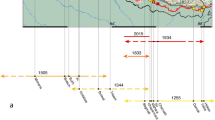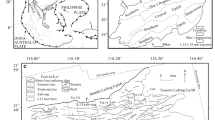Abstract
Colluvial wedges collapsed from fault scarp can also be used to study reverse faulting paleoearthquakes. Generating processes of reverse faulting colluvial wedges are much more complex than those associated with normal faulting earthquakes. Reverse faulting colluvial wedge is also in triangle shape, and dies away from the fault. Contact between the fault and the colluvial wedge may be a simple straight reverse fault or a combination of an erosive surface in the upper part and a reverse fault in the lower part. Contents and grain sizes increase near the fault and along the base of a colluvial wedge. Based on examples from the piedmont reverse fault and fold along the northern Tainshan, we studied characteristics of reverse faulting colluvial wedges, and discussed the generating processes of reverse faulting colluvial wedges. Reverse faulting generates an unstable scarp hanging in the air immediately after an earthquake. Fallen material deposits along the base of newly formed fault scarp. Erosive surface and surface of colluvial wedge form an antithetic scarp with an opposite direction to underlain reverse fault. If the later stage colluvium covers both the early stage colluvium and the erosive surface, the colluvial wedge will have a curved vertical edge with reverse fault in the lower part and erosive surface in the upper part. If the erosive surface is not covered by later stage colluvium, the colluvial wedge will only have a simple straight vertical edge, which is the reverse fault. A colluvial wedge represents a paleoearthquake event, but the height of the wedge is not equal to vertical offset of the paleoearthquake.
Similar content being viewed by others
References
Wallace, R. E., Profiles and ages of young fault scarps, north-central Nevada, Geol. Soc. Am. Bull., 1977, 88(9): 1267.
Wallace, R. E., Patterns and timing of late Quaternary faulting in the Great Basin Province and relation to some regional tectonic features, J. Geophys. Res., 1984, 89(B7): 5763.
Schwartz, D. P., Coppersmith, K. J., Fault behavior and characteristic earthquakes: Examples from the Wasatch and San Andreas Fault zones, J. Geophys. Res., 1984, 89(B7): 5681.
Deng Qidong, Wang Yipeng, Liao Yuhua et al., Colluvial wedges and Holocene history of tectonic activity along the Helan range-front fault, Chinese Science Bulletin, 1984, 29(9): 557.
Crone, A. J., Introduction to directions in paleoseismology, U. S. G. S. Open-File Report, 1987, 87–673: 1.
Yeats, R. S., Prentice, C.,S., Introduction to specialsection: Paleoseismology, J. Geophys. Res., 1996, 101(B3): 5847.
Deng Qidong, Feng Xianyue, Zhang Peizhen et al., Paleoseismology in the northern piedmont of Tianshan Mountain, northwestern China, J. Geophys. Res., 1996, 101(B3): 5895.
Deng Qidong, Feng Xianyu, You Huichuan et al., Paleoseismology and Quaternary activity of the Dushanzi-Anjihai active reverse fault zone, Research on Active Faults, 1991, (1): 37.
Deng Qidong, Feng Xianyu, Yang Xiaoping et al., Paleoseismology and Holocene slip rate of the Manas-Tugulu active reverse fault and fold zone revealed by large sized trench exposure, Research on Active Faults, 1993(3): 1.
Zhang Peizhen, Deng Qidong, Xu Xiwei et al., Blind thrusting, folding earthquake, and the 1906 Manas earthquake, Geology and Seismology, 1994, 16(3): 193.
Author information
Authors and Affiliations
About this article
Cite this article
Deng, Q., Zhang, P. Colluvial wedges associated with pre-historical reverse faulting paleoearthquakes. Chin.Sci.Bull. 45, 1598–1604 (2000). https://doi.org/10.1007/BF02886221
Received:
Issue Date:
DOI: https://doi.org/10.1007/BF02886221




